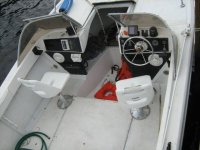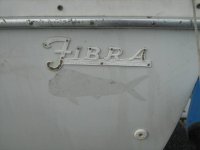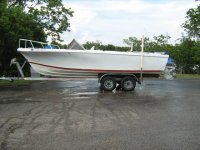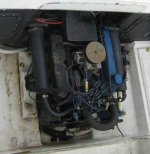Here is the text of the court's decision in Hunt Industries, Inc. v. Fibra Boats, Inc. 299 F. Supp. 1145 in which the court found the Fibra hull design infringed on the Hunt patent. I am a lawyer and found this on Westlaw. Because the Fibra hull infringed on Hunt's patent, Fibra could not make the hull without a license, and this is probably why they went out of business.
Actually, I need to cut this into 3 parts so I do not go over the allowed 10k characters.
United States District Court,
S.D. Florida.
HUNT INDUSTRIES, INC., Plaintiff,
v.
FIBRA BOATS, INC., Defendant.
No. 67-901-Civ.
May 16, 1969.
Action for damages for alleged infringement of patent. All issues except whether patent was valid and infringed were severed for later trial. The District Court, Cabot, J., held that claim four of letters patent No. 3,085,535 embracing a particular design of small boat high speed planing hull was valid and infringed.
Cause set for further trial.
Trial of this action was had before the court sitting without a jury on December 17, 18, and 19, 1968, between the plaintiff, Hunt Industries, Inc., a Massachusetts corporation, assignee of United States Letters Patent Number 3,085,535, embracing a particular design of small boat high speed planing hull, and the defendant, Fibra Boats, Inc., a Florida corporation, manufacturer of a competing small boat hull.
The issues tried are only two:
(1) Whether Claim 4 of United States Letters Patent Number 3,085,535 is valid.
(2) If Claim 4 of the patent is valid, whether defendant's boat hull infringes said claim.
By stipulation of counsel all other issues raised by the pleadings (the complaint and answer; the counterclaim and reply) were severed to be later tried, if necessary. These other issues are: (1) damages due plaintiff by defendant; (2) anti-trust violations by plaintiff; (3) interference by plaintiff with advantageous business relationships of defendant.
The court has considered the pleadings, the evidence, and the advices of counsel, both written and oral, is otherwise duly advised in the premises, and makes the following:
*1147 FINDINGS OF FACT
]
In developing the hull, the inventor, in the Spring of 1957, launched a 23 foot wooden prototype with a centerboard and driven by a single inboard engine mounted amidships, and in the Spring of 1958, a 16 foot wooden prototype powered by an outboard motor and incorporating a water ballast tunnel. In July and September, 1958, two 23 foot fiberglass prototypes with centerboards and inboard engines mounted amidships were built.
A continuous program of experimenting and testing of the prototypes was carried on by the inventor through the Spring and Summer of 1959, with the fiberglass hulls being used as tenders during the American's Cup Races which were held over a period of several months into October of 1958.
On August 24, 1959, Charles R. Hunt filed a patent application disclosing the hull described in the foregoing and also disclosing in all claims a water ballast tunnel for stability of the boat while in operation at low speeds and while at rest.
During the prosecution of the patent, a period of almost four years, amended claims were filed eliminating the water ballast tunnel. These ultimately became Claim 4, the claim here controverted. The patent, Number 3,085,535, was issued on April 16, 1963, to the plaintiff, Hunt Industries, Inc., as assignee of Charles R. Hunt.
[1] The basic statutory provisions under which this controversy arose are found in Title 35 of the United States Code. Sections 101-103 specify the requirements of patentability that must appear in subject matter capable of being patented. They are: novelty; usefulness; and non-obviousness; and concurrence of all three is necessary for patentability. Graham v. John Deere Co., 1966, 383 U.S. 1, 86 S.Ct. 684, 15 L.Ed.2d 545; Zero Mfg. Co., Inc., v. Miss. Milk Prod. ***'n., 5 Cir. 1966, 358 F.2d 853. A patent is not novel, and therefore not patentable, if it has been disclosed by being ‘patented or described in a printed publication in this or a foreign country, or in public use, or on sale in this country, more than one year prior to the date of the application for patent. * * *’ 35 U.S.C. 102(b). It is obvious and therefore not patentable, though not identically disclosed under 102(b) ‘if the differences between the subject matter sought to be patented and the prior art are such that the subject matter as a whole would have been obvious at the time the invention was made to a person having ordinary skill in the art. * * *’ 103.
[2] [3] [4] A patent is presumed to be valid and the burden of establishing invalidity rests on the party asserting it. 35 U.S.C. 282. Since the defendant here contends that subject patent is invalid, the defendant carries the burden of submitting proof of invalidity and that burden is greater than the preponderance of the evidence rule, which applies to civil cases generally. The proof *1148 of invalidity must be clear and convincing, with all reasonable doubts resolved in favor of validity. Patterson-Ballagh Corp., et al. v. Moss, et al., 9 Cir. 1953, 201 F.2d 403; Warner & Swasey Company, et al. v. Universal Marion Corp., D.C.Col.1963, 237 F.Supp. 719. And when unpatented devices, orally testified to, are relied upon to defeat the patent, the proof must be ‘clear, satisfactory, and beyond a reasonable doubt.’ The Barbed Wire Patent, 1892, 143 U.S. 275, 284, 12 S.Ct. 443, 447, 36 L.Ed. 154.
The defendant alleges that Claim 4 of plaintiff's patent is invalid on the theories of (1) obviousness, (2) prior use and sale, and (3) delayed claiming.
OBVIOUSNESS
[5] [6] In determining the obviousness or non-obviousness of the subject matter, three steps are involved: first, a determination of what the prior art was; second, identification of the subject patent and what, if any, improvement the patentee has made over the prior art; and third, whether the improvement would have been obvious to one skilled in the art. Monroe Auto Equipment Co. v. Heckethorn Mfg. & Supply Co., 6 Cir. 1964, 332 F.2d 406, 411; Swofford, et al. v. B & W, Inc., 5 Cir. 1968, 395 F.2d 362; Graham v. John Deere Co., supra. And the test of obviousness is not hindsight but must be analyzed from the standpoint of the state of the art at the time of the development of the invention. Blumcraft of Pittsburgh v. Citizens and Southern National Bank of South Carolina, D.C.S.C.1968, 286 F.Supp. 448; Preformed Line Products Co. v. Fanner Mfg. Co., 328 F.2d 265, 271, 6 Cir. 1964, cert. denied, 379 U.S. 846, 85 S.Ct. 56, 12 L.Ed.2d 51.
[7] In examining the prior art, any pertinent references not considered by the patent office as disclosed by the file wrapper will serve to weaken the presumption of validity, but of course, any overlooked references must be pertinent, for as stated in Otto v. Koppers Co., Inc., 4 Cir. 1957, 246 F.2d 789, 801, ‘Astute and enterprising attorneys can always find references not of record in the Patent Office, but if they do not involve some substantial element in the defense of anticipation which was not considered by the Patent Office, the failure to make them record references cannot weaken the statutory presumption.’
[8] The defendant submitted no prior patents of boat hulls not cited by the patent office, so it is presumed none were found and, of course, the presumption of validity which arises from issuance of the patent also applies to the distinctions found by the patent office in the patents cited by them as having been considered.
The defendant did submit five patents of seaplane floats or pontoons as evidence of prior art, but the court finds them not pertinent for a variety of reasons, but primarily because their function is entirely different from that of a high speed planing boat hull; the pontoons merely soften the impact of the plane in landing or floating on the water, stability is provided by two pontoons or outriggers, and the plane depends on its wings for lift rather than the planing of the pontoons.
A number of publications were offered by defendant as showing that the Hunt hull was described in printed publications more than one year prior to filing date in an effort to defeat the novelty requirement. But none of these show steep deadrise angle at the transom approaching that of subject invention, nor the constant flat cross-sections extending more than half the length of the lower hull portion, nor the substantial ratio of length to beam, nor the high chine in relation to normal displacement waterline, all characteristics of the Hunt hull, nor are any shown to have produced the superior seakeeping qualities of the patented hull; the ‘soft’ ride, stability, and ease of handling, especially in rough water.
*1149 [9] And even if defendant's references were pertinent, the presumption of validity, though weakened, still exists. Warner & swasey Company, et al. v. Universal Marion Corp., supra.
Reader is required to view PDF images.







